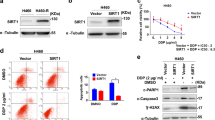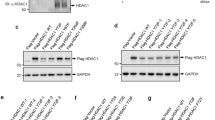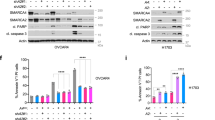Abstract
Aberrant regulation of the pRB/E2F1 pathway has been invariably linked to inappropriate proliferation and/apoptosis in human cancers. Therefore, understanding the intricacies of the signaling pathway and identification of novel E2F1 targets involved in apoptosis could pave way for new therapeutic manipulation. Here, we identified CTSL2 (cathepsin L2/cathepsin V) as a novel E2F1 target that participates in E2F1-dependent apoptosis. We showed that E2F1 directly binds to CTSL2 promoter and that CTSL2 is regulated by both exogenous and endogenous E2F1. RNAi-mediated depletion of CTSL2 effectively abrogated ectopic E2F1-induced apoptosis, coupled with reduced lysosomal membrane permeabilization (LMP) and mitochondrial membrane depolarization. CTSL2 knockdown also inhibited apoptosis mediated by the endogenous E2F1 activated by DNA damage. Furthermore, we showed that CTSL2 depletion in cancer cells resulted in inhibition of histone deacetylase inhibitor (HDACi)-induced apoptosis, and conversely ectopic overexpression of CTSL2-sensitized cancer cells to HDACi. This study uncovered a novel E2F1 target implicated in LMP and apoptosis activation, as well as in the modulation of HDACi and chemotherapeutic drugs response.
This is a preview of subscription content, access via your institution
Access options
Subscribe to this journal
Receive 50 print issues and online access
$259.00 per year
only $5.18 per issue
Buy this article
- Purchase on Springer Link
- Instant access to full article PDF
Prices may be subject to local taxes which are calculated during checkout






Similar content being viewed by others
References
Wu Z, Zheng S, Yu Q . The E2F family and the role of E2F1 in apoptosis. Int J Biochem Cell Biol 2009; 41: 2389–2397.
Iaquinta PJ, Lees JA . Life and death decisions by the E2F transcription factors. Curr Opin Cell Biol 2007; 19: 649–657.
Polager S, Ginsberg D . E2F—at the crossroads of life and death. Trends Cell Biol 2008; 18: 528–535.
Lowe SW, Cepero E, Evan G . Intrinsic tumour suppression. Nature 2004; 432: 307–315.
Ginsberg D . E2F1 pathways to apoptosis. FEBS Lett 2002; 529: 122–125.
Hallstrom TC, Mori S, Nevins JR . An E2F1-dependent gene expression program that determines the balance between proliferation and cell death. Cancer Cell 2008; 13: 11–22.
Dynlacht BD . Live or let die: E2F1 and PI3K pathways intersect to make life or death decisions. Cancer Cell 2008; 13: 1–2.
Putzer BM . E2F1 death pathways as targets for cancer therapy. J Cell Mol Med 2007; 11: 239–251.
Bates S, Phillips AC, Clark PA, Stott F, Peters G, Ludwig RL et al. p14ARF links the tumour suppressors RB and p53. Nature 1998; 395: 124–125.
Stiewe T, Putzer BM . Role of the p53-homologue p73 in E2F1-induced apoptosis. Nat Genet 2000; 26: 464–469.
Irwin M, Marin MC, Phillips AC, Seelan RS, Smith DI, Liu W et al. Role for the p53 homologue p73 in E2F-1-induced apoptosis. Nature 2000; 407: 645–648.
Moroni MC, Hickman ES, Lazzerini Denchi E, Caprara G, Colli E, Cecconi F et al. Apaf-1 is a transcriptional target for E2F and p53. Nat Cell Biol 2001; 3: 552–558.
Tan J, Zhuang L, Jiang X, Yang KK, Karuturi KM, Yu Q . Apoptosis signal-regulating kinase 1 is a direct target of E2F1 and contributes to histone deacetylase inhibitor-induced apoptosis through positive feedback regulation of E2F1 apoptotic activity. J Biol Chem 2006; 281: 10508–10515.
Nahle Z, Polakoff J, Davuluri RV, McCurrach ME, Jacobson MD, Narita M et al. Direct coupling of the cell cycle and cell death machinery by E2F. Nat Cell Biol 2002; 4: 859–864.
Hershko T, Ginsberg D . Up-regulation of Bcl-2 homology 3 (BH3)-only proteins by E2F1 mediates apoptosis. J Biol Chem 2004; 279: 8627–8634.
Zhao Y, Tan J, Zhuang L, Jiang X, Liu ET, Yu Q . Inhibitors of histone deacetylases target the Rb-E2F1 pathway for apoptosis induction through activation of proapoptotic protein Bim. Proc Natl Acad Sci USA 2005; 102: 16090–16095.
Putzer BM, Stiewe T, Crespo F, Esche H . Improved safety through tamoxifen-regulated induction of cytotoxic genes delivered by Ad vectors for cancer gene therapy. Gene Ther 2000; 7: 1317–1325.
Lin WC, Lin FT, Nevins JR . Selective induction of E2F1 in response to DNA damage, mediated by ATM-dependent phosphorylation. Genes Dev 2001; 15: 1833–1844.
Pediconi N, Ianari A, Costanzo A, Belloni L, Gallo R, Cimino L et al. Differential regulation of E2F1 apoptotic target genes in response to DNA damage. Nat Cell Biol 2003; 5: 552–558.
Jiang X, Tan J, Li J, Kivimae S, Yang X, Zhuang L et al. DACT3 is an epigenetic regulator of Wnt/beta-catenin signaling in colorectal cancer and is a therapeutic target of histone modifications. Cancer Cell 2008; 13: 529–541.
Zhang Y, Yang ND, Zhou F, Shen T, Duan T, Zhou J et al. (-)-Epigallocatechin-3-Gallate Induces Non-Apoptotic Cell Death in Human Cancer Cells via ROS-Mediated lysosomal membrane permeabilization. PLoS One 2012; 7: e46749.
Blomgran R, Zheng L, Stendahl O . Cathepsin-cleaved Bid promotes apoptosis in human neutrophils via oxidative stress-induced lysosomal membrane permeabilization. J Leukoc Biol 2007; 81: 1213–1223.
Bolden JE, Peart MJ, Johnstone RW . Anticancer activities of histone deacetylase inhibitors. Nat Rev Drug Discov 2006; 5: 769–784.
Santamaria I, Velasco G, Cazorla M, Fueyo A, Campo E, Lopez-Otin C . Cathepsin L2, a novel human cysteine proteinase produced by breast and colorectal carcinomas. Cancer Res 1998; 58: 1624–1630.
Sevenich L, Hagemann S, Stoeckle C, Tolosa E, Peters C, Reinheckel T . Expression of human cathepsin L or human cathepsin V in mouse thymus mediates positive selection of T helper cells in cathepsin L knock-out mice. Biochimie 2010; 92: 1674–1680.
Ivanova S, Repnik U, Bojic L, Petelin A, Turk V, Turk B . Lysosomes in apoptosis. Methods Enzymol 2008; 442: 183–199.
Droga-Mazovec G, Bojic L, Petelin A, Ivanova S, Romih R, Repnik U et al. Cysteine cathepsins trigger caspase-dependent cell death through cleavage of bid and antiapoptotic Bcl-2 homologues. J Biol Chem 2008; 283: 19140–19150.
Jaattela M, Cande C, Kroemer G . Lysosomes and mitochondria in the commitment to apoptosis: a potential role for cathepsin D and AIF. Cell Death Differ 2004; 11: 135–136.
Wu ZL, Zheng SS, Li ZM, Qiao YY, Aau MY, Yu Q . Polycomb protein EZH2 regulates E2F1-dependent apoptosis through epigenetically modulating Bim expression. Cell Death Differ 2010; 17: 801–810.
Johnstone RW . Histone-deacetylase inhibitors: novel drugs for the treatment of cancer. Nat Rev Drug Discov 2002; 1: 287–299.
Tan J, Yang X, Zhuang L, Jiang X, Chen W, Lee PL et al. Pharmacologic disruption of polycomb-repressive complex 2-mediated gene repression selectively induces apoptosis in cancer cells. Genes Dev 2007; 21: 1050–1063.
Kreuzaler PA, Staniszewska AD, Li W, Omidvar N, Kedjouar B, Turkson J et al. Stat3 controls lysosomal-mediated cell death in vivo. Nat Cell Biol 2011; 13: 303–309.
Wu ZL, Zheng SS, Li ZM, Qiao YY, Aau MY, Yu Q . Polycomb protein EZH2 regulates E2F1-dependent apoptosis through epigenetically modulating Bim expression. Cell Death Differ 2010; 17: 801–810.
Acknowledgements
We thank Dr Kristian Helin for the ER-E2F1 plasmids, Dr Joseph Nevins for the adenoviral E2F1, Dr Andrew Turnell for adenoviral E1A and Dr Claudio Brancolini for IMR90-E1A cells. We are grateful to Li Juntao for providing assistance in data analysis. This work was supported by the Agency for Science, Technology and Research for Singapore.
Author information
Authors and Affiliations
Corresponding author
Ethics declarations
Competing interests
The authors declare no conflict of interest.
Rights and permissions
About this article
Cite this article
Wong, C., Wu, Z. & Yu, Q. CTSL2 is a pro-apoptotic target of E2F1 and a modulator of histone deacetylase inhibitor and DNA damage-induced apoptosis. Oncogene 33, 1249–1257 (2014). https://doi.org/10.1038/onc.2013.72
Received:
Revised:
Accepted:
Published:
Issue Date:
DOI: https://doi.org/10.1038/onc.2013.72



